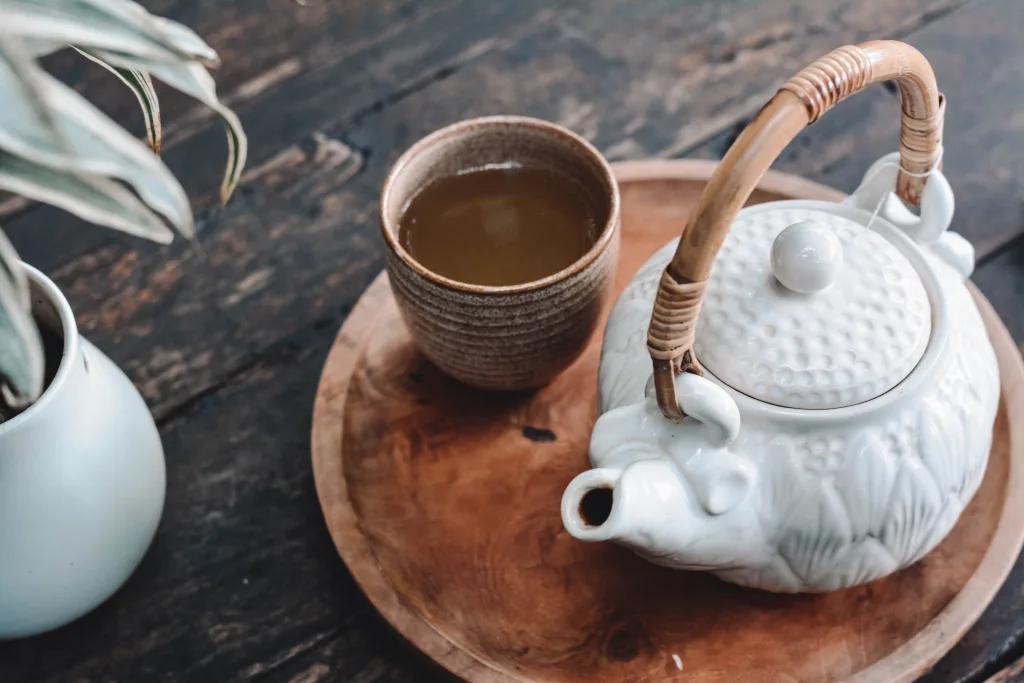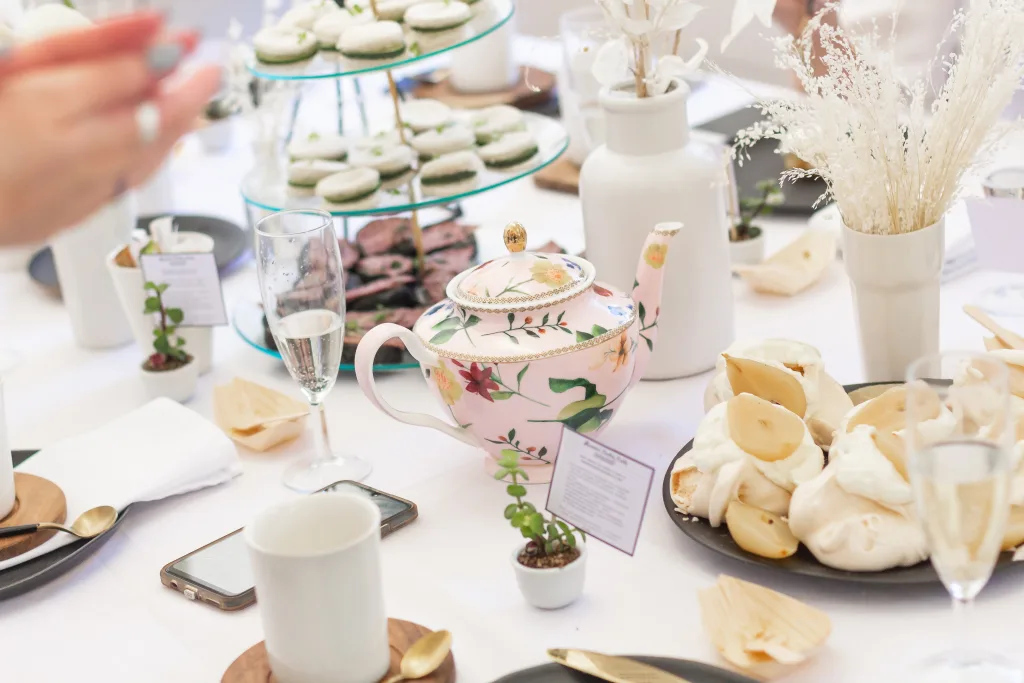Teatime, also known as Afternoon Tea, has a long-standing tradition and has become an integral part of British culture. But when exactly is teatime? Let’s delve into the history and customs surrounding this delightful ritual.
Teatime typically occurs between 3 and 4 pm, serving as a bridge between the light lunches and late dinners that were common in the early 1800s. Originally, it was not meant to replace dinner but rather to fill the gap between an early lunch and a late evening meal. This timing allowed people to satisfy their hunger and maintain their energy levels until dinner, which was often served fashionably late.
The concept of Afternoon Tea as we know it today can be traced back to Anna, the seventh Duchess of Bedford, who introduced it in England in 1840. The Duchess found herself feeling hungry around four o’clock in the afternoon, with dinner still several hours away. To curb her appetite, she began requesting a tray of small sandwiches, scones, biscuits, and tea to be brought to her room during this time.
This practice eventually caught on and became a trend among the upper classes. Afternoon Tea became not only a meal but also a social event, where friends would gather to enjoy each other’s company and indulge in an array of delectable treats.
The traditional Afternoon Tea spread typically includes finger sandwiches, such as cucumber and cream cheese or smoked salmon and dill. Scones, served with clotted cream and jam, are another staple of teatime. Alongside these, you’ll find an assortment of cakes, pastries, macaroons, and other bite-sized delights, all meticulously arranged on ornamental three-tier serving trays.
In modern times, Afternoon Tea is still served around 3 or 4 pm, adhering to its historical roots. However, it is no longer limited to the upper classes and has become more accessible to people from all walks of life. Many hotels, tea rooms, and cafes now offer their own versions of Afternoon Tea, allowing everyone to experience this delightful tradition.
So, whether you’re a fan of the classics or prefer a contemporary twist on the traditional Afternoon Tea, you can indulge in this delightful ritual at the designated teatime hour. It’s a wonderful way to take a break from the hustle and bustle of daily life, relax with friends or family, and savor a selection of delicious treats.
Teatime, or Afternoon Tea, is usually served between 3 and 4 pm. Its origins can be traced back to the 1800s when it was introduced by the Duchess of Bedford. Today, it remains an integral part of British culture, offering a delightful and indulgent experience for all who partake. So, why not treat yourself to a spot of tea and enjoy the delights of teatime?
What Time Of The Day Is Teatime In England?
Teatime in England typically refers to the afternoon tea tradition, which is usually enjoyed between 3 and 4 pm. This tradition originated in the early 1800s as a way to bridge the gap between lunch and dinner. During teatime, a variety of delicious treats are served, including finger sandwiches, scones, cakes, macaroons, and other delectable bites. It is a lavish affair, often accompanied by a selection of teas. The timing of teatime allows people to satisfy their hunger and enjoy a light meal before the evening meal.

Is 3pm Tea Time?
Traditionally, 3 p.m. is considered tea time. Afternoon tea, as it is commonly known, is a British tradition that dates back to the early 19th century. It was introduced as a way to bridge the gap between lunch and dinner, which were served at different times in the past.
During afternoon tea, a selection of teas are served along with a variety of finger foods such as sandwiches, scones, cakes, and pastries. This light meal is typically enjoyed in a relaxed and social setting, often accompanied by friends or family.
While the exact timing of afternoon tea can vary depending on personal preferences and cultural differences, it is generally served around 3 or 4 p.m. these days. This time allows for a small break in the day to indulge in the pleasure of tea and treats.
The tradition of afternoon tea has evolved over time, and nowadays, it is not limited to just British culture. Many countries and cultures have embraced the concept of afternoon tea and have their own variations. In some places, it may be referred to as high tea or even have different serving times.
3 p.m. is commonly recognized as tea time, specifically for afternoon tea. However, it is worth noting that different cultures and individuals may have their own interpretations and preferences regarding tea time.
Why Is Tea Time At 4PM?
Tea time is traditionally scheduled for 4 pm, serving as a bridge between an early lunch and a late dinner. The purpose of this afternoon ritual is not to replace dinner but rather to offer a light refreshment to curb hunger and provide a pleasant break in the day. During tea time, a variety of delicacies are typically served on small ornamental three-tier serving trays, including small sandwiches, scones, biscuits, and of course, tea.
The timing of tea time at 4 pm has historical roots and cultural significance. In the early 19th century, Anna, the Duchess of Bedford, is credited with popularizing the notion of afternoon tea. During this time period, it was common for the upper class to eat a substantial breakfast, followed by a light lunch around noon. However, the gap between lunch and dinner, which was typically served late in the evening, often left people feeling hungry and fatigued.
Anna devised the idea of having a small meal with tea in the afternoon to combat this mid-day slump. She found that having a light repast consisting of tea and small bites helped her regain energy and stave off hunger until dinner. This practice quickly caught on among her social circle, and soon afternoon tea became a fashionable and popular activity.
The choice of 4 pm for tea time seems to be rooted in practicality. It falls in the middle of the afternoon, providing a suitable break from daily activities. It allows individuals to rest, socialize, and enjoy a light meal before the evening meal. Additionally, 4 pm is typically late enough to ensure that tea time is not too close to lunch, yet early enough to avoid interfering with dinner preparations.
Tea time at 4 pm serves as a delightful interlude between lunch and dinner. It offers a chance to relax, socialize, and indulge in a variety of delectable treats. The timing of 4 pm strikes a balance between providing sustenance and avoiding interference with other meals, making it an ideal time for this cherished tradition.
Why Is Teatime In The Afternoon?
Teatime, also known as afternoon tea, has been traditionally observed in the afternoon hours in England. This practice originated in the 19th century, specifically in the year 1840, when Anna, the seventh Duchess of Bedford, introduced it.
The Duchess experienced hunger pangs around four o’clock in the afternoons. During that time, the evening meal in her household was served fashionably late at eight o’clock, leaving a considerable gap between lunch and dinner. To curb her hunger, the Duchess began requesting a tray of tea, bread, and butter be brought to her room during the late afternoon. This simple act eventually evolved into a social event.
The popularity of afternoon tea quickly spread among the upper classes in England. It became a fashionable way to bridge the gap between lunch and dinner, providing a light meal to satisfy hunger until the main evening meal. The practice of afternoon tea soon extended beyond the Duchess’s personal routine and became a social gathering for friends and acquaintances.
Teatime typically consists of a selection of tea, scones, pastries, sandwiches, and other small treats. It is served on a tiered stand, with the most substantial items at the bottom and the lighter ones at the top. The tea is usually served in fine china cups, accompanied by milk, sugar, and sometimes lemon.
In terms of timing, teatime is generally observed between 3:30 pm and 5:00 pm. This timeframe allows for a break in the day, providing an opportunity to relax, socialize, and enjoy some light refreshments. It is considered a quintessentially British tradition and is still enjoyed by many today.
Teatime in the afternoon originated from the Duchess of Bedford’s hunger and desire to have a small meal between lunch and dinner. It has since evolved into a social occasion and a cherished tradition in England, offering a delightful break in the day for tea lovers and food enthusiasts alike.

Conclusion
Teatime, also known as Afternoon Tea, traditionally takes place between 3 and 4 pm. It originated in the early 1800s as a way to bridge the gap between light lunches and late dinners. The Duchess of Bedford introduced the concept in England in 1840, as she found herself hungry in the afternoon before the fashionable dinner time of 8 pm. Afternoon Tea is typically an elaborate affair, featuring finger sandwiches, scones, cakes, macaroons, and other delicious treats. It is not meant to replace dinner but rather to provide a satisfying and enjoyable meal to fill the gap between lunch and dinner. So, if you find yourself craving a delightful and indulgent break in the late afternoon, consider embracing the tradition of teatime and treat yourself to a delightful spread of tea and scrumptious delights.
